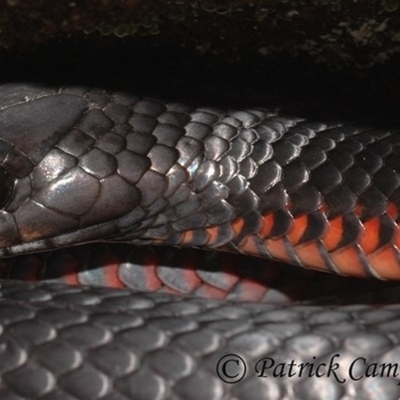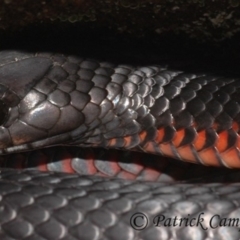Pseudechis porphyriacus (Red-bellied Black Snake)
Body colour is uniform glossy black, with black edged, red belly scales and bright red lower flanks adjacent to the belly scales.
It can grow to 2 m in length although the average size is about 1.4 m.
It could be confused with the Eastern Small-eyed Snake, which has smaller eyes and pinkish-red belly scales that do not have black edges and the colour does not extend up the sides of the body.
It is common along the main rivers and creeks and is also found on the ranges where it shelters beneath fallen timber, cavities below ground and large rock slabs.
The Red-bellied Black Snake gives birth to an average of 20 young which emerge from membranous sacs within an hour of being delivered. The species is often associated with wet environments and has been observed foraging beneath water in search of tadpoles, frogs or fish.
It is venomous and, although no human fatalities have been recorded, bites to the hand may result in amputation of the fingers due to the substantial tissue damage that is caused by compounds in the venom. The Red-Bellied Black Snake is typically a placid and inoffensive animal that is reluctant to bite unless provoked. However, if provoked it will flatten its neck and turn side on to the attacker while retreating to cover. It is also capable of delivering a bite without injecting venom. These ‘dry bites’ are usually delivered when they are accidentally stepped on. In other cases, the Red-bellied Black Snake will recoil their body hitting a person’s legs with the tail, giving the impression of being bitten. Black snakes will occasionally prey on large brown snakes, although the reverse is also true.
Pseudechis porphyriacus is listed in the following regions:
Canberra & Southern Tablelands | Southern Highlands | Albury, Wodonga | South Coast | Greater Sydney | Hunter Region | Riverina Murray | New South Wales North Coast
Species information
- Pseudechis porphyriacus Scientific name
- Red-bellied Black Snake Common name
- Not Sensitive
- Local native
- Non-Invasive
- Up to 1428.4m Recorded at altitude
- 244 images trained Machine learning
Follow Pseudechis porphyriacus
Receive alerts of new sightings
SubscribeLocation information
-
Maps
Albury Alpine Bega River Bioblitz Ben Boyd National Park Bendora Reservoir Bermagui State Forest Berrima Biamanga National Park Bimberamala National Park Bimberi Nature Reserve Boro Bournda Environment Education Centre Bournda National Park Braemar Brindabella National Park Broulee Moruya Nature Observation Area Bullen Range Bundanoon Colo Vale Conjola Bushcare Cooleman Ridge Cotter Reserve Cotter Reservoir Currarong - Abrahams Bosom Beach Deua National Park Eurobodalla National Park Exeter Fadden Hills Pond Felltimber Creek NCR Gibraltar Pines Gigerline Nature Reserve Ginninderry Conservation Corridor Googong Foreshore Horseshoe Lagoon and West Albury Wetlands Illilanga & Baroona Jerrabomberra Wetlands Kama Kambah Pool Kosciuszko National Park Lake Tuggeranong Lanyon - northern section A.C.T. Lions Youth Haven - Westwood Farm A.C.T. Lower Cotter Catchment Lower Molonglo McDonald State Forest McQuoids Hill Medway Melrose Meroo National Park Milton Rainforest Walking Track Mittagong Mogo State Forest Molonglo River Reserve Monga National Park Mongarlowe River Mount Imlay National Park Mungabareena Murramarang National Park Nadgee Nature Reserve Nail Can Hill Namadgi National Park Panboola Penrose Point Hut Hill Point Hut to Tharwa Rob Roy Range Rugosa Shoalhaven Heads Bushcare South East Forest National Park South Pacific Heathland Reserve Stony Creek Stranger Pond Swamp Creek Tharwa Bridge The Pinnacle Tidbinbilla Nature Reserve Tynans TSR Uriarra Recreation Reserve Wadbilliga National Park Wairo Beach and Dolphin Point Wallagoot LALC Wandiyali-Environa Conservation Area Welby West Stromlo Wingecarribee Local Government Area Wodonga Wodonga Regional Park Wonga Wetlands Woodstock Nature Reserve -
Survey points
Bemboka River Reserve FTD120: TNR Boardwalk Milton Rainforest -
Places
Barratta, NSW Mathoura, NSW Paddys River, ACT








